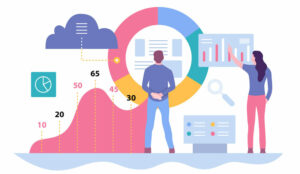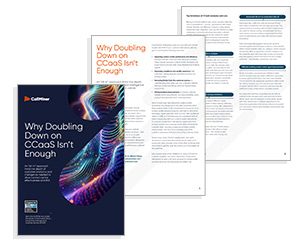CallMiner introduce us to customer analytics and how it is used in the contact centre.
Companies looking to approach the marketplace from a position of preparedness aim to align their offerings with consumers’ collective desires. Doing so requires that those in charge either consult a crystal ball or implement a precise customer analytics strategy.
Customer analytics bridges the wide gap between a business’s assumptions and their target demographic’s actual preferences. Without incorporating the use of customer analytics solutions into their plans, companies can completely miss the mark with ill-conceived development trajectories.
With customer analytics in active use, an organization can closely align its own development goals with its clientele’s varied expectations.
For information on the role of speech analytics within the broader category of customer analytics, download our whitepaper 10 Ways Speech Analytics Empowers the Entire Enterprise.
Read on to discover what makes customer analytics so powerful in providing actionable developmental insights to growing companies.
Definition of Customer Analytics
Customer analytics encompasses all manner of customer data processing; however, studying customer actions and journeys within your organization over time is particularly important to this process.
This area of business intelligence diverges from the rest in a few specific ways:
Individualized Analysis
Where other types of business metrics roll diverse data sets into comprehensive catch-all metrics, customer analytics focuses in on individual customer data instead. Detailed data-gathering is done on specific customers to build out insightful and thorough models of their behavior.
The depth of detail that is considered through this approach yields unique analytical results not possible with more generalized metrics.
Defining Thought Patterns
Customer analytics is generally concerned with the reasons individual customers choose the actions they take. The customer’s thoughts leading up to taking an action are just as important as the specific action they take.
By focusing plenty of attention on the underlying motivations for specific actions, customer analytics yields highly accurate forecasting information around which companies can structure their plans.
Time-Sensitive
As opposed to many types of metrics that consider only real-time fluctuations in business conditions, customer analytics tends to incorporate full-picture perspectives of all actions taken by customers to date. This further reinforces the power of this form of analytics to assist in predicting future behavior.
Metrics Assessed Through Customer Analytics
Many individual metrics can be leveraged to flesh out the customer analytics process. Below are a few common metrics customer analytics companies can leverage:
Transactions
Keeping track of individual customers’ transaction histories paints a clear picture of their purchasing habits with your company. Customer analytics approaches may vary, but this data is often combined with brand engagement, churn rate and more to describe specific facets of a company’s customer relations.
Website Users
Businesses with a digital storefront or growing online presence often track website users as a part of their overall customer analytics strategy. Besides tracking overall users in a given time period, individual users’ website usage habits are also often assessed alongside their satisfaction rates.
Abandonment Rates
Using critical metrics such as prospects’ abandonment rate, business leaders can more accurately map out the purchasing process at their company. The motivations of customers who choose not to follow through with a purchase can be discovered through the combined use of this metric and purchase intent, which assesses prospective customers’ likelihood of placing an eventual purchase.
Customer Effort
Customer effort scores are also important to include in many customer analytics systems, as they highlight lapses in customer service along the customer’s journey.
Customer effort scores can be paired with overall transaction counts to help determine whether increasingly frictionless service standards pose significant benefits to your business’s bottom line.
Common Customer Analytics Complications
Although customer analytics offers up a wealth of powerful functions for business leaders to utilize, misguided use of such can occasionally cause needless confusion. The following complications are important to avoid when implementing a customer analytics strategy within your organization:
Omitting Statistical Analysis
Although certain data points and variables can appear to line up in particularly extensive data sets, it is important to adopt reasonable analysis processes to rule out false impressions.
Seeing trends where there may only be random correlation can misinform many attempts at growth, but falling back on sound statistical analysis should keep such conundrums from occurring with any regularity.
Analyzing First, Asking Questions Later
Approaching the process of conducting customer analysis without having any clear questions to answer is unlikely to prove profitable or useful at all.
Identify key areas worth investigating first and foremost before assessing customer behavior in full to derive greater benefit from your findings.
Customer analytics sheds light on the general needs, interests and perceptions harbored by your company’s customers, allowing you to make pivotal alterations to your business to better suit them.
By harnessing the potential of customer analytics, your company can plot a profitable course for future growth and greater market share – always with your customers in mind.
This blog post has been re-published by kind permission of CallMiner – View the Original Article
For more information about CallMiner - visit the CallMiner Website
Call Centre Helper is not responsible for the content of these guest blog posts. The opinions expressed in this article are those of the author, and do not necessarily reflect those of Call Centre Helper.
Author: CallMiner
Published On: 24th Feb 2021
Read more about - Guest Blogs, CallMiner






 CallMiner is the leading cloud-based customer interaction analytics solution for extracting business intelligence and improving agent performance across all contact channels.
CallMiner is the leading cloud-based customer interaction analytics solution for extracting business intelligence and improving agent performance across all contact channels. 












